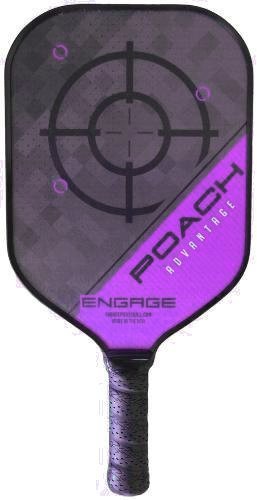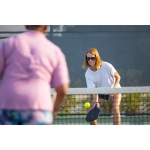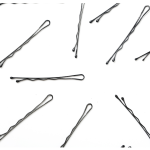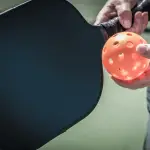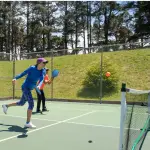Racquet sports have been in vogue for decades now, with games like badminton, table tennis, and tennis enjoying widespread recognition, huge fan followings, and entire resorts and video games dedicated to them.
Today, however, some of the less mainstream racquet sports have been picking up the pace, and you can find athletes training to win pickleball and paddleball championships as well. And while these games have been around since the 1950s, their popularity has only skyrocketed in the last decade, with pickleball being named the fastest growing sport in the USA!
But most of us are still quite unsure of the distinction between pickleball and paddleball. And some of us have heard the name ‘padel’ as well which is a completely different sport. So what’s the difference?
Let’s Start with Pickleball
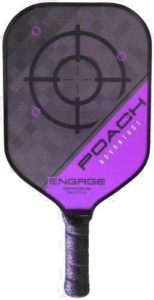
Pickleball was created by three dads from Bainbridge Island, Washington to give their kids a different form of recreation. The game employs rules that are quite similar to badminton, with the players playing on a court that’s roughly the size of a badminton court.
There are, however, a few key differences between pickleball and badminton. The racquets for pickleball (known as paddles) do not come with nets, and are more like large table tennis paddles usually made of wood or graphite.
The ball used is perforated and the sport can be played both indoors and outdoors. If you’re familiar with tennis or volleyball, the rules of this sport should be easy enough to understand. You’re allowed to play singles and doubles, and any individual or team must score eleven points to win the game.
The pickleball net also differs starkly from a badminton or volleyball net. In fact, it’s more closely related to the net used in tennis, where it’s fixed in one place and close to the ground.
Pickleball has gained immense popularity in the recent decade and is regulated by an official board called the USAPA (USA Pickleball Association).
Paddleball and Padel
Paddleball and Padel are often mistaken for each other due to the similarity in equipment and game mechanics. However, the two games are actually quite different from each other and it’s important to keep in mind when you’re deciding which sport to pick up.
Paddleball
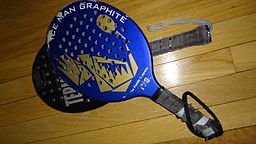
Paddleball is usually played on a court that’s 50 feet long and 20 feet wide. The difference between paddleball and pickleball is the absence of a net in paddleball. Instead, a 16-inch wall serves as a sort of net on which players must hit the ball, ensuring it crosses the ‘service line’ before their opponent whacks it back on the wall and the game continues. So, in a sense, paddleball is a lot more similar to squash, but employs one basic rule of pickleball, where only the serving team or individual is capable of scoring points.
The scoring system, however, isn’t similar to pickleball at all. Paddleball uses a scoring system similar to tennis, with the first point being 15, the second 30, the third 40, and the fourth ‘game’. You must score 6 ‘games’ to win a set, with matches being played in the best of three sets.
Paddleball racquets are quite similar to those used in padel with a perforated surface with holes. This minimises air friction and allows players to guide the ball as accurately as possible to a particular spot on the wall.
Padel
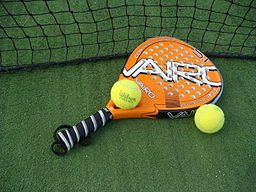
Padel (or Paddle Tennis, which is it’s more popular name) originated in Mexico and is often confused with paddleball. To simplify, you could say that this game is a mix of pickleball and paddleball.
The sport became very popular in Spain, which has been hosting the World Padel Tour since 2005. However, over the years, Padel is becoming extremely popular in other parts of Europe and the United States as well.
Padel is played in a court that’s roughly two-thirds the size of a tennis court, with fences or walls on all four sides of the court. There’s a net in the middle of the court, similar to tennis but a little lower than the regular net used in tennis. There are no doors to enter the court, and access to the court can be found on both sides of the court near the nets.
The paddles are often made of solid, foam-like material with a perforated surface. The ball looks exactly like a tennis ball to those of you who aren’t familiar with Padel. However, unlike a tennis ball, padel balls are less pressured making it easier to keep them within the dimensions of the smaller court.
Game Play
Another reason the balls are less pressured is because of the way this game is played. Unlike pickleball and paddleball, padel utilizes both the net and the surrounding fences during a match.
Players must serve underhanded and the ball should pitch once on the other court before any action is taken. The difference is that the ball may hit the structure on the side or the back before being returned by the opponent. Similarly, you may use the walls on your side of the court to send the ball over to the other side. This makes for a variety of different trajectories and increases the unpredictability and excitement of the game. The game is scored exactly like tennis, with players requiring six games to win a set.
What’s Your Favorite?
Now that the confusion has been cleared up, which one of these sports would you like to play most? Today, there are over 3000 pickleball courts across the United States, with Paddleball and Padel growing steadily in popularity.
And while all three may differ slightly in the rules, they do have one thing in common – they are excellent ways of staying healthy, bonding with your family, having fun, and practicing mindfulness.
So if you’re looking to pick up a new leisure activity that will help you unwind and stay connected to your body, you’ve got three sports to choose from. And because they’re so closely related, getting good at one will improve your game play in the other two!
So give them all a shot and see which one works for you.

